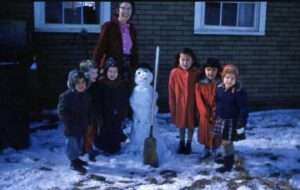
Snow — Qaniq (falling), Aniuq (on ground)
Qaninguq. – It is snowing
Although the Kodiak Archipelago does not receive large quantities of snow, snow cover is present between December and March and remains in the region’s high interior mountains throughout the year. For Alutiiq people, frozen landscapes presented both opportunities and challenges.
Winter in the Alutiiq homeland is a great time to travel overland. Wind-packed snow can make walking easier than in the warm season when people on foot must wrestle through a thick tangle of brush and tall grasses. Overland travel across frozen lakes was easier. Elders remember walking great distances in the winter, traveling between communities with the help of temporary snowshoes woven from green alder branches or a flexible spruce bough. More permanent shoes were carved from alder branches and fitted with a webbing of whale sinew.
Although overland travel is easier in winter, snowdrifts bury wood and brush, making it more difficult to collect firewood. Alutiiq people used hand-pulled sleds to move drift logs and cut timber in the snow. These sleds had narrow runners, sometimes made of spruce roots, to prevent sinking. One man would push the sled while another pulled. However, people did not employ dogs in pulling sleds.
To many Alutiiq Elders, a heavy snow cover is a sign of future prosperity. Some believe that a snowy winter will bring a good berry crop, while others say that heavy snows foretell strong salmon runs.
Listen to podcast at the Alutiiq Museum’s website
